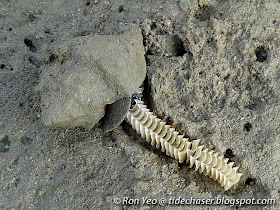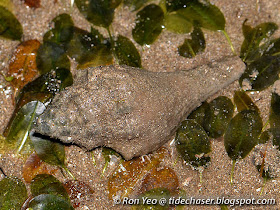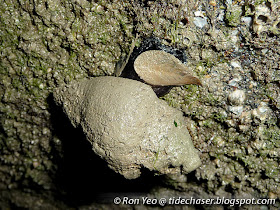Marine snails of the family Melongenidae, commonly called melongenas, are carnivorous snails that typically have a drop-shaped or oval operculum and strong foot. Some species has been observed to use its operculum as an anchor to drag and move around. Most species feed on clams and oysters, though some are observed to feed on barnacles as well. They generally feed by inserting the proboscis into the gaps between the shells of barnacles and clams.

Many species are very well-camouflaged, trapping sediment with a layer of fine hair on the shell. The egg capsules are arranged like little dominoes, either in an arc or a crooked line.
I have personally seen two melongena species in Singapore so far (thanks to Siong Kiat who gave tips on how to identify them!). You may want to take a look at my diagram on the parts of a snail's shell if you are not familiar with the names of the parts, so as to better understand the terms used below.

The Ternate Melongena (Hemifusus ternatanus) has a long siphon canal. Ternate is an island in the Moluccas of eastern Indonesia. Note the drop-shaped operculum and black foot.

Live Ternate Melongenas are seldom seen, but dead shells occupied by hermit crabs are occasionally seen on our shores. This species is found on sandy substrates, growing to about 10cm long.

The Spiral Melongena (Pugilina cochlidium) is very commonly seen on the muddy intertidal shores in Singapore, feeding mainly on barnacles and clams. While most can be found half hidden in the mud, some can be found on rocks as well, growing up to more than 10cm long. Like the previous species, it has a drop-shaped operculum and black foot as well.

The siphon canal of the Spiral Melongena is much shorter than that of the previous species. This slightly cleaner specimen reveals the brownish shell colour. This snail is collected for food in the region.
References

Many species are very well-camouflaged, trapping sediment with a layer of fine hair on the shell. The egg capsules are arranged like little dominoes, either in an arc or a crooked line.
I have personally seen two melongena species in Singapore so far (thanks to Siong Kiat who gave tips on how to identify them!). You may want to take a look at my diagram on the parts of a snail's shell if you are not familiar with the names of the parts, so as to better understand the terms used below.

The Ternate Melongena (Hemifusus ternatanus) has a long siphon canal. Ternate is an island in the Moluccas of eastern Indonesia. Note the drop-shaped operculum and black foot.

Live Ternate Melongenas are seldom seen, but dead shells occupied by hermit crabs are occasionally seen on our shores. This species is found on sandy substrates, growing to about 10cm long.

The Spiral Melongena (Pugilina cochlidium) is very commonly seen on the muddy intertidal shores in Singapore, feeding mainly on barnacles and clams. While most can be found half hidden in the mud, some can be found on rocks as well, growing up to more than 10cm long. Like the previous species, it has a drop-shaped operculum and black foot as well.

The siphon canal of the Spiral Melongena is much shorter than that of the previous species. This slightly cleaner specimen reveals the brownish shell colour. This snail is collected for food in the region.
References
- Abbott, R. T., 1991. Seashells of Southeast Asia. Graham Brash, Singapore. 145 pp.
- Carpenter, K. E. and V. H. Niem (eds). 1998-2001. FAO species identification guide for fishery purposes. The living marine resources of the Western Central Pacific. Volumes 1 to 6. FAO, Rome. pp. 1-4218.
- Chan, S.-Y. 2009. The Melongenidae (Mollusca: Gastropoda) of Singapore. Nature in Singapore, 2: 63–67.
- Gladys Archerd Shell Collection at Washington State University Tri-Cities Natural History Museum. 2008. Retrieved September 26, 2012, from http://shells.tricity.wsu.edu/ArcherdShellCollection/ShellCollection.html.
- Oliver, A. P. H. 2012. Philip's guide to seashells of the world. Philip's, London. 320 pp.
- Tan, K. S. & C. L. Phuah. 1999. Diet and feeding habits of Pugilina cochlidium (Neogastropoda: Melongenidae). Singapore Journal of Molluscan Studies 65 (4): 499-501
- Tan, K. S. & L. M. Chou, 2000. A guide to common seashells of Singapore. Singapore Science Centre, Singapore. 168 pp.
- Tan, S. K. & H. P. M. Woo, 2010. A preliminary checklist of the molluscs of Singapore. Raffles Museum of Biodiversity Research, National University of Singapore, Singapore. 78 pp. Uploaded 02 June 2010.
- Tan, S. K. & R. K. H. Yeo, 2010. The intertidal molluscs of Pulau Semakau: preliminary results of “Project Semakau”. Nature in Singapore, 3: 287–296.
- World Register of Marine Species. 2012. Retrieved Oct 3, 2012, from http://www.marinespecies.org.

No comments:
Post a Comment